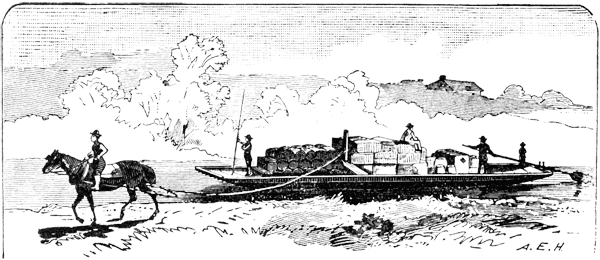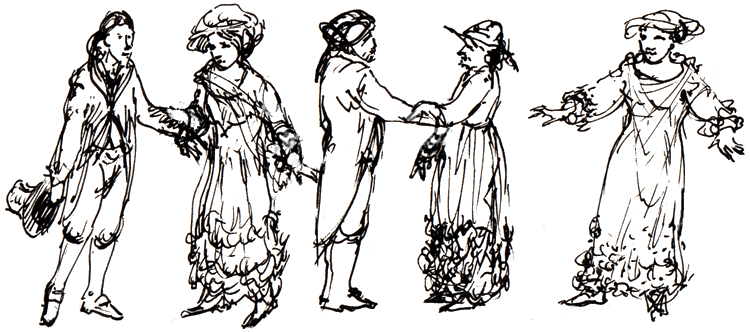



Middlesex Canal Association P.O. Box 333 Billerica, Massachusetts 01821
|
Volume 42 No. 2 |
Special Edition |
December 2003 |
CANAL COMPLETED
CELEBRATION PLANNED
Just 200 years ago, Col. Loammi Baldwin, the supervisor of construction for the Middlesex Canal, announced that the Canal would be completed by the end of 1803. (Ed. note: He missed by two hours.) At the same time he issued invitations to a "grand jubilee" celebration to be held at the 1790 House, which now stands adjacent to the Baldwin Mansion across the canal.
The construction had taken ten years, the period specified in the enabling Act of the Massachusetts General Court. We refer to this period as the Bicentennial Decade, now drawing to a close. Accordingly, we intend to emulate the Colonel's actions, and have scheduled a party on January 1, 2004 to commemorate the occasion. All are welcome to participate in this social event, to be held at the Middlesex Canal Museum-Visitor Center in North Billerica as detailed on p. 1 of this announcement.
One can well imagine the elation this occasion brought to the attendees in 1803. Building the Canal had been a tremendous undertaking for a small population in a new nation. They had just created the longest canal in the Western Hemisphere, using only manual tools to move dirt and shape rock, all with private funding.
The Bicentennial Bash brings an opportunity to recapture their excitement; wearing costumes reminiscent of the period will make it festive. We will be encouraged in pressing ahead with our program outlined on p. 5, just as they were on theirs. Lastly, but by no means least, the Bash will bring together our community of canal-lovers who enjoy this unique slice of American history.
WELCOME TO THE BICENTENNIAL BASH!
We’re planning a grand party to celebrate the end of the Bicentennial Decade of the Middlesex Canal, just as Col. Loammi Baldwin did 200 years ago. You’re all invited to come, perhaps in some sort of costume (see p.7), for a strictly social occasion at the Canal Museum-Visitor Center (see also p. 7 for directions) on Thursday, January 1, 2004 from 2 to 5 p.m. We’ll start off with hot mulled cider, wine, and cheese, enjoy a brief mixer (Who Am I?) soon after, then sit for a few words of greeting by our President Nolan Jones before enjoying some famous canal songs and a sing-along led by the Troubadour of the Middlesex Canal, Paul Wiggins. Finally will come some delectables, such as Baldwin apple and mince pies, ham biscuits, and gingerbread, and we’ll go home with happy memories of the Middlesex Canal etched in our minds!
EVENTS TO MARK THE BICENTENNIAL DECADE
Construction began on the Middlesex Canal in 1794 and was completed in ten years. Two hundred years later the Middlesex Canal Association designated the corresponding period as the Bicentennial Decade and has presented an appropriate event each of those ten years, as follows:
1993
A play was written focusing on the crucial meeting of the Proprietors in 1793,
where the decision was made to proceed according to the enabling Act of the
Massachusetts General Court specifying a ten-year limit. The play was performed
in theater-in-the-round format at the Senior Center in Medford close by the
location of the actual meeting, all actors appearing in period costume. A song,
"Haulin’ Down to Boston on the Middlesex Canal" was composed as a
finale to this show, and performed by the Canal Troubadour, Paul Wiggins. The
show was videotaped and later broadcast on local television.
1994
In September 1794, a groundbreaking ceremony was held on the bank of the Concord
River beside the dam in North Billerica. A reenactment was performed at the same
exact spot. Costumed officials of the Middlesex Canal Company arrived in a
horse-drawn carriage to turn shovels of dirt and repeat the original
pronouncements.
1995
A lecture was presented at the Lowell National Park Headquarters as it might
have been by Superintendent of Construction, Col. Loammi Baldwin; its content
included the surveying of the route, construction techniques, and working
conditions.
1996
A lecture was presented at the Thompson Library in Woburn describing the life of
James Sullivan, the prime mover in the building of the Canal, later to become
Governor of Massachusetts. The talk was followed by a report from Tom Raphael on
activities in progress to preserve and enhance the canal.
1997
A lecture was presented at Lowell describing the Pawtucket Canal, built in 1796
by the merchants of Newburyport to bypass the formidable falls of the same name
in the Merrimack River at Lowell. It was considered a competitor of the
Middlesex Canal, but instead became the first source of waterpower for the
Lowell mills. The talk was followed by a boat ride on the River.
1998
The boats and boating companies that operated on the Middlesex Canal were the
subject of a Bicentennial lecture at a facility of the Winchester Hospital
adjacent to the Baldwin Mansion in Woburn. This topic was supplemented by a talk
on the construction of a replica of a packet boat by its principal builder, Len
Harmon, who also described its summertime use on a watered section of the Canal
beside the Mansion.
1999
A biographical account of Col. Loammi Baldwin and his talented sons was
presented at the same location as above, focusing on his role in a host of civic
enterprises other than the Canal, along with the equally significant
contributions of his sons.
2000
Extending the Canal to and through Boston to the waterfront was, the subject of
a lecture at the Charlestown Navy Yard. The extension was created not by the
Middlesex Canal Company but by Boston merchants who recognized its commercial
potential, thereby enabling the Company to pay its first dividend. This lecture,
like those previously described, was prepared and delivered by Dave Dettinger,
who also scripted the two opening events.
2001
Bill Gerber addressed the provision of canals along the Merrimack River from
Lowell to Concord, New Hampshire to overcome impediments to transportation, such
as falls and rapids; the Middlesex Canal Company added or improved existing
channels and locks in a dozen locations.
2002
Howard Winkler presented the final talk of the series; his topic was a study of
the cost of the Canal when built as compared with costs in the 21st century,
thereby dramatizing the burden of the original investment. His talk and the
prior talk were presented at the Canal Museum.
2003
Plans are afoot for a celebration of the Canal’s completion, emulating the
gala event of December 1803. (see p.1)
THE CANAL MUSEUM AND ITS HISTORICAL SETTING
The bank of the Concord River in North Billerica is an ideal location for the Middlesex Canal Museum-Visitor Center, surrounded, as it is by reminders of that early period in American history when transportation and industry were beginning to shape the nation’s future. The millpond created here not only provided water for the Canal in both directions, it also powered typical mills of that formative period, one of which hosts the Museum itself.
As early as 1708, Christopher Osgood obtained a "privilege" to put the River to use by erecting a dam at North Billerica incorporating the rocks where the river began a sharp drop. It was not long before the gristmill he built was joined by others, including a sawmill, a forge, and a fulling mill; a community grew up there. In 1782 an entrepreneur, Thomas Richardson consolidated the privilege and began leasing these facilities.
A major step by the fledgling Middlesex Canal Company was its purchase in 1794 of Richardson’s holdings; a bonus was their acquisition of the sawmill and forge, both needed for the construction of locks and bridges. The dam was improved over the years in order to ensure a sufficient supply of water for the mills and the Canal. A wooden structure built in 1793 was replaced by masonry in 1828; this dam with a few modifications is the one that exists today.
Soon other mills arose to capitalize on the waterpower the milldam offered. First came Francis Faulkner, arriving in 1811. Starting out by leasing, he ultimately built the impressive brick factory that faces the River; it continued in operation as late as 1987. The Talbot brothers arrived in 1839. They too began by leasing, and then erected a brick textile mill adjacent to Faulkner’s. Under its mill yard platform lot may be glimpsed a fragment of an original canal lock, including the quoin, a granite column with a vertical hollow that housed the hinge portion of a lock gate.
The Faulkner Mill was purchased by Ron Paré in the mid-1990s; after extensive renovation he provided office space for small companies. In 1996, he offered two large rooms to the Middlesex Canal Association for use as a museum. Across the road, he built an attractive lookout at a point where in the early 1800s strollers paused to watch canal boats cross the River using the floating towpath. Near the opposite end of the dam may be found a large rock bearing an iron ring to which the floating towpath was tethered.
Establishing the Canal Museum has been a huge cooperative venture by members of the Middlesex Canal Association and the Billerica Section of the Middlesex Canal Commission. Many volunteers under the leadership of Shayne and John Reardon of Billerica completed the interior buildout. Betty Bigwood and Tom Dahill of the Association have led the way in developing displays of maps, paintings, photographs, and artifacts, along with working models, all arranged to bring to life the construction, operation, and flavor of the historic Middlesex Canal. Completed in 2001, the, Museum is open on Saturdays and Sundays from April through September; it is also available for rental by groups.
|
LOOKING AHEAD |
|
|
1804 |
2004 |
|
|


For those who may wish to improvise a costume for the Bicentennial Bash,
Tom Dahill has sketched above some couples dressed in the style of the 1800s.
Rentals are available but are not inexpensive; for the early reenactments we
relied on the Costume Company at 444 Massachusetts Ave. in Arlington.
Directions
By Car: From Greater Boston and Route 128/95: From Burlington, take Route 3 North for about 7 miles to Exit 28 "Treble Cove Road, N. Billerica, Carlisle". At the end of the ramp turn left onto Treble Cove Road toward North Billerica. At about ¾ mile bear left at a fork. After about another ¾ mile you'll come to a traffic light; this is Route 3A; go straight. (Go to "Common Directions", below)
From Greater Lowell and Route 495: Take Route 3 South to Exit 29 "Route 129, Billerica, Chelmsford". At the end of the ramp turn right onto Route 129 toward Billerica. Go about 1¼ miles; bear right onto Route 3A South. Go about 0.1 mile to a traffic light at Treble Cove Road; turn left. (Go to "Common Directions", below)
Common Directions (continued from above): Go about ¼ mile to a 3-way fork; take the middle road which will put St. Andrew's Church on your left. Go about ¼ mile; bear right then turn right onto Faulkner Street. Go about ¼ mile; the Museum is on your left and you can park across the street on your right, just beyond the falls.
By Train
The Lowell Commuter Line runs between Boston's North Station and Lowell's Gallagher Terminal. Get off at the North Billerica station, which is one stop south of Lowell. From the station side of the tracks, the Museum is a 2-minute walk down Faulkner Street, on the right side.
Editor’s note: Dave Dettinger has been the driving force behind all of the Bicentennial Decade events. In every case, he either gave the talk or found the speaker. Where no attribution is given, it was Dave who wrote the script, prepared the lecture, or composed the song.